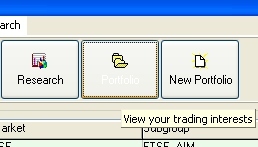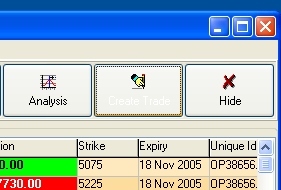How to Trade
Firstly, open your portfolio, or create a
new one.

To make a trade within StockWave™ we use the trade creator, which is accessed from the portfolio.

To execute a trade, you have to know what the trade is, obviously, and you have to have an account with a broker who offers the desired trade (not all do). Usually this execution will involve a phone call and a verbal instruction which is quite straightforward and easy if all you are doing is buying some stock — but when you start to try more complicated things, it is very easy to get mixed up, and perhaps get things the wrong way round; the consequences of which could be rather nasty.
Since verbal instruction is still very popular, StockWave™ has a facility which will describe in words the trade you have just created; you can read this off the screen when you phone your broker. When doing combination trades it is important to check whether or not the composite trades will attract multiple or single costs, e.g., if you want to do a straddle — which is a combination of two trades — you don't want to pay double the transaction charges.
Why phone calls and verbal instruction, why not make it all automatic?
In theory it would be better to have automatic secure online execution, with time-stamped authentication and guaranteed prices, but this is not available (yet, anyway); also it does have its drawbacks — we could find ourselves associated with a particular broker (who may not always have the best prices), or if we try to support multiple brokerages, our development costs could skyrocket. For now at least, our practical recommendation is for the user to maintain multiple accounts with various online brokerages of his choice — these all have Web-based interfaces, so you can just open up a browser window to access their info whilst you are running StockWave™. The only disadvantage of this is the need for the user to manually enter (bid, offer) price information — we hope you don't find this too burdensome.
The physical acts involved in trading are thus:
- Do some analysis
- Open the trade creator
- Select the analysis you want to use
- Create a trade, either manually or using the trade search
- Check the payoff statistics; repeat the process until you find something you are happy with
- Execute the trade
The trade will be entered into your portfolio automatically, and a trading alarm is set which will warn you if the price is going badly against you. Note that this alarm will still be active if your portfolio is closed, as long as the program is running. Any warnings will be sent by email. The trade alarm creates regions on the price chart which represent safe or dangerous behaviour for the share price — if the share price crosses into a red region, or stays there for a significant period, you will get a warning. These regions do not represent current profit or loss values but how 'on-track' the trade is to achieve a profit at its expected expiry time.
Note well the first step in the process — before you make any trade you should have some idea where the market is going, and a good reason for such confidence — you need to do some analysis.
There are at least three types of information you need to consider to properly analyze a stock:
- You need to look at the chart.
- Check the news files.
- Look at the fundamentals; going even deeper than this into their business structure and relationships would not be a bad idea either.
In short, you have to look at everything — there are plenty of people who claim that only one of these is important — we take the view you need to take a global view.
